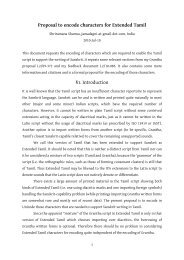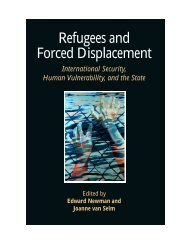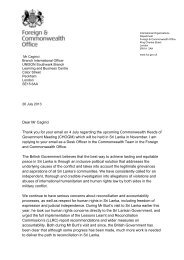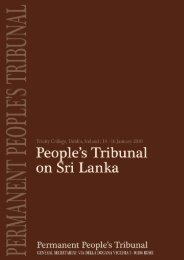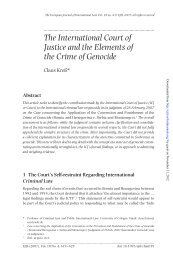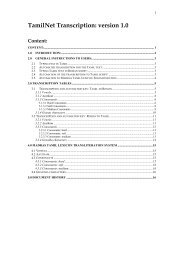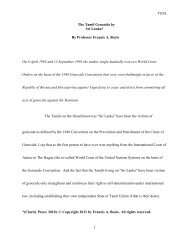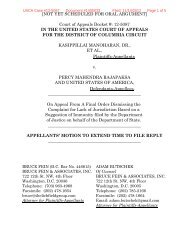Untitled - International Commission of Jurists
Untitled - International Commission of Jurists
Untitled - International Commission of Jurists
Create successful ePaper yourself
Turn your PDF publications into a flip-book with our unique Google optimized e-Paper software.
have been adjourned by the relevant High Court judge for weeks. 551 In instances<br />
where trial is by a judge sitting alone, due to the large number <strong>of</strong> cases to be heard,<br />
the witnesses are not given sufficient time to record their statements and are required<br />
to attend court on several occasions.<br />
Quite <strong>of</strong>ten the adjournment between two trial dates where the same witness<br />
gives testimony can range from a couple <strong>of</strong> months to even to two years. Also,<br />
it is usual for differences in testimony to occur due to forgetfulness as a result<br />
<strong>of</strong> long delays and this leads inevitably to acquittals. 552<br />
Delays are also occasioned by the lackadaisical nature <strong>of</strong> prosecutions as well as by<br />
the failure <strong>of</strong> other government departments, such as the Government Analyst’s<br />
Department, to submit necessary reports to court on time. 553 This shortcoming was<br />
illustrated in the Kumarapuram Case even after the lapse <strong>of</strong> two years. The long delay<br />
in the Chemmani Case examined above is another illustration <strong>of</strong> such delayed trial<br />
processes. Indeed, the long pending nature <strong>of</strong> such prosecutions, which can amount to<br />
up to several years, has been a prevalent feature from the 1980’s onwards. 554 Delay in<br />
the trial process is a major reason for acquittals in prosecutions <strong>of</strong> grave human rights<br />
violations.<br />
The delayed prosecutorial process in such cases is contrasted with other instances<br />
where the prosecutorial and the judicial systems have functioned with remarkable<br />
speed. This is exemplified in the manner in which the respective trials into the<br />
shooting <strong>of</strong> a High Court judge and the shooting <strong>of</strong> a torture victim on 21 November<br />
2004 were conducted. (The killing <strong>of</strong> the first victim occurred coincidentally two days<br />
prior to the killing <strong>of</strong> the second victim.) The trial concerning the assassination <strong>of</strong><br />
Judge Sarath Ambepitiya was conducted day-to-day before a trial-at-bar, consequent<br />
to immediate police investigations and apprehension <strong>of</strong> the suspects, and was<br />
concluded within seven months (the accused were found guilty and the convictions<br />
were upheld on appeal). In contrast, the indictments against the suspects in the killing<br />
<strong>of</strong> the torture victim, Gerald Perera was only issued after the lapse <strong>of</strong> several months<br />
and the murder trial is still pending. 555<br />
7.3. Judicial approaches in acquittal cases<br />
This section focuses on some stark contrasts historically in the willingness <strong>of</strong> the<br />
judiciary to convict in cases such as Bindunuwewa, discussed above. 556 In that case,<br />
the Supreme Court overturned the High Court conviction <strong>of</strong> the accused. This<br />
example appears to be part <strong>of</strong> a pattern that prevailed across many High Court cases,<br />
in which there is a tendency to acquit where enforced disappearances are alleged, and<br />
551 de Silva, Samith, op. cit.<br />
552 ibid.<br />
553 Delays in this instance are commonly attributed to lack <strong>of</strong> resources.<br />
554 Amnesty <strong>International</strong>, ‘Sri Lanka; An Assessment <strong>of</strong> the Human Rights Situation’, AI Index,<br />
ASA/37/1/93, 1993, at p. 3.<br />
555 Pinto-Jayawardena, Kishali ‘The Rule <strong>of</strong> Law in Decline; Study on Prevalence, Determinants and<br />
Causes <strong>of</strong> Torture and other Forms <strong>of</strong> Cruel, Inhuman or Degrading Treatment or Punishment in Sri<br />
Lanka’, The Rehabilitation and Research Centre for Torture Victims (RCT) Denmark, 2009.<br />
556 See section 3.7, Chapter Two, above (Illustrative Cases).<br />
155



